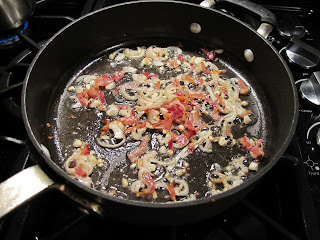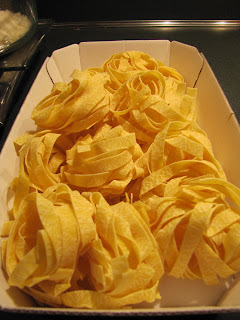I've been a little lax with my posting lately. I've been working on a conference paper that is the first fruits of my dissertation research. It took several weeks to drag all my disparate thoughts together into a reasonably coherent argument, but I was happy with the result and the presentation, which I gave this past weekend, went well. So now I can get back to focusing on cooking (which is really more important, right?). Fortunately for you, I made a killer recipe on Tuesday and actually remembered to take a few pictures.
I really am a baker at heart (my favorite words are "cream the butter and sugar together"), so any opportunity to bring those skills to the dinner table is a good one, in my eyes. This savory, rustic tart is just the thing. A buttery, flaky pie dough filled with sweet, delicate sauteed onions? Come on! Who wouldn't love it? And it's fairly quick - you just have to make the dough in advance. I love it so much, I think I'm going to make it again for the department potluck next week.
The recipe called for store-bought, frozen pie dough, but since I am now anti-prepared foods I threw one together myself. I did not use the savory tart shell recipe that I posted back in October. While delicious, it tends to be fairly difficult to roll out. Every time I've done it I've had lots of rips and tears to fix once it was in the tart pan. Since this is a free-form tart, it needs a sturdier dough than that - one that can handle being moved around without breaking. Instead, I used the basic pie crust from my Baking Bites cookbook, which produced a beautiful, buttery result. With the egg wash on top, it reminded me more of a flaky turnover dough than a tart dough. While I'm sure you could use frozen pie dough for this, I wholeheartedly recommend making your own. The result is better and so much more satisfying!
Single Pie Crust
From The Baking Bites Cookbook.
1 1/4 c flour
1/4 tsp salt
1 tsp sugar
8 tbsp cold butter, cut into small chunks
4-5 tbsp ice water (I needed just about 5)
Combine your flour, salt and sugar in a food processor. Pulse to combine. Add the chunks of butter and pulse until no pieces larger than a pea remain. Add ice water and mix until the dough comes together as a ball. (If you don't have a food processor, combine the butter with the flour mixture using your hands or a pastry cutter.) Form the dough into a small disc, wrap it in plastic wrap and store it in the refrigerator for at least one hour before using.
Rustic Vidalia Onion Tart
From the Southern Living Farmers Market Cookbook (my favorite!).
2 tbsp butter
4 medium-sized Vidalia onions, thinly sliced (or any other sweet onion - about 6 1/2 c total, or whatever will fit into your tart - I used three huge onions and it was far too much)
1 1/2 tsp chopped fresh rosemary (I used a large pinch of dried rosemary)
3/4 tsp salt
1/2 tsp pepper
1 egg white, beaten
3/4 c shredded Gruyere, divided
one 9" pie crust
Preheat oven to 425°. Melt the butter in a large non-stick skillet over medium-high heat. Add the onion, rosemary, salt and pepper (if you have too much onion for your skillet, just put in what fits - it'll be too much for your pie crust, too). Cook, stirring occasionally, about 8 minutes, or until tender (if the onion starts browning, turn down the heat).
Roll out the pie crust on a lightly floured surface into a 12" circle (yes, circle - try to keep it as close to round as you can, since the shape of your dough will end up being the shape of your tart!). Place the pie crust on a parchment-lined baking sheet (I was out of parchment so I just used baking spray and it turned out fine). Brush the dough with egg white. Sprinkle 1/2 c Gruyere around the center of the crust. Spread the onion mixture over the cheese, leaving a 2 1/2" wide boarder. Sprinkle the remaining 1/4 c cheese over the onion. Fold the pie crust border up and over the onion, pleating as you go, leaving a 4"-wide opening at the center. Brush the crust with egg white.
Bake at 425° on the bottom oven rack for 17-19 minutes, or until crust is golden (I did it in my small top oven which only has one rack, and it took about 25 minutes to get that golden look). Let stand 5 minutes before serving.






































